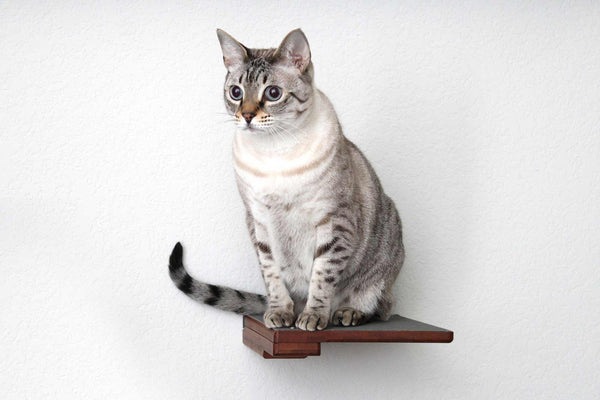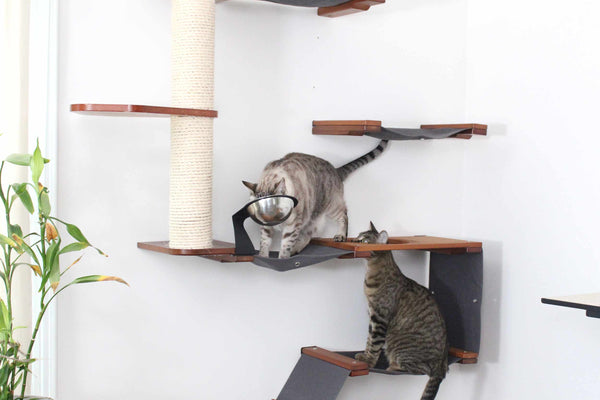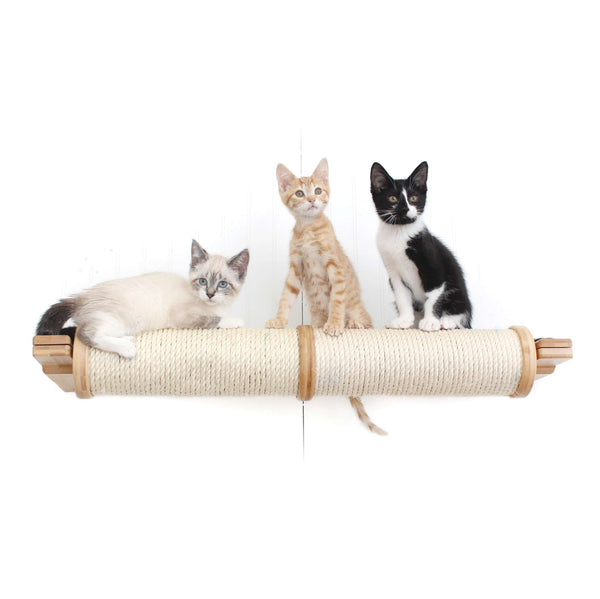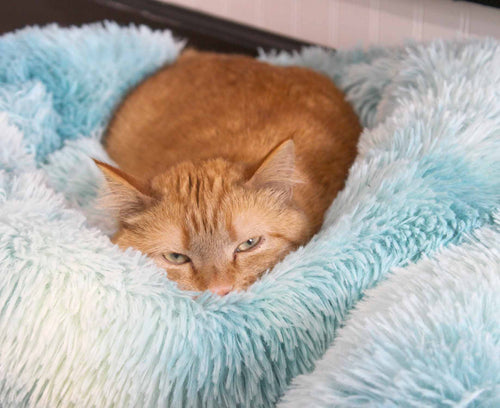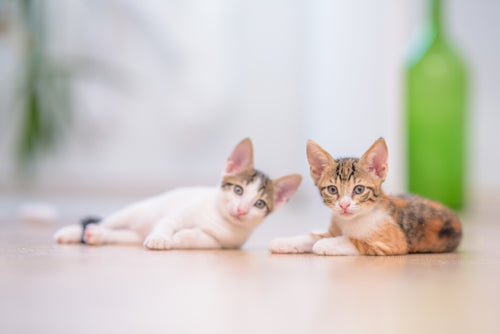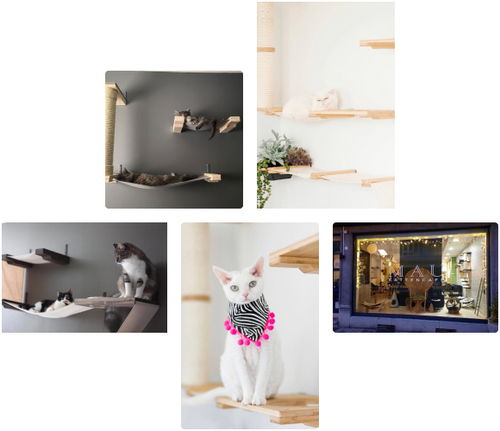Getting Cat and Dog to Get Along - Tips for Integrating Dogs and Cats
In our previous post, we discussed plans for bringing a new pet home and setting up an environment for success for both animals. Now that you have management in place, and both pets have had a chance to settle in, how do we go about introducing Fido and Whiskers?
Do not be tempted to try the “let’s see what happens” approach. Not only could this lay a bad foundation for their relationship, but it could be potentially dangerous as well. Instead, gradual and steady is going to be the secret to a good cat-dog relationship.
Foundation Skills
Before you begin to introduce the two, it is helpful if both animals know a few basic foundation skills to begin with.
Attention
The first thing we need is an animal who will happily offer you attention. You will start in a low distraction area, and have about 10 small, tasty treats in your hand:
Wait for your pet to look up at you (don’t get too concerned about direct eye contact at this stage – what we are looking for is attention and focus on you).
Use a word like “yes!” to mark the moment they give you attention, then drop a treat on the floor for them to eat.
Wait for your pet to eat the treat and look back up at you.
Mark again with “yes!” and drop another treat. Repeat.
Start adding a cue, such as the pet’s name, right before they look up.
Video ExamplesCat: https://youtu.be/ibxY7p6prtwDog: https://youtu.be/Oe5QsAZf-3A
Hand Target
A hand target (pet touching their nose to your hand) is a very easy behavior to train, and can be a simple way to get your pet to come to you, move, change position, etc. in case your dog starts to get overly interested in their new feline friend, or vice versa. Simply present your hand a couple inches from their nose. When they move forward and sniff, bumping your hand in the process, say “yes” and deliver a treat. Repeat.
Video ExamplesCat: https://youtu.be/CNOv3f3gHKkDog: https://youtu.be/TWjfsAO1NWE
Stationing
Teaching your pet to place themselves on a mat or platform will be a helpful skill when you begin sessions with both of them present. A dog that is resting on a mat can’t be chasing the cat, and a cat that is perching on a station can’t be taunting or swatting at a dog. Teach this skill first without the other pet present:
Approach the mat with your pet and as they start to step on it, drop treats. Continue to deliver treats for several seconds.
Toss a “re-set cookie” a few feet to the side so that your pet moves off and is ready for another repetition. Before throwing the cookie, you can give a “release word” such as “OK” or “break” which will be your pet’s cue to move off the station in the future.
As your pet heads back to the mat, begin rewarding on the mat again.
If they sit or lie down, reward that.
Once they are consistently offering a sit or down on the station, you can only reward when they are in that position so that it becomes the default behavior once they get to the mat.
Video ExamplesCat: https://youtu.be/4R1-K430DxoDog: https://youtu.be/53_R7276b_k
Putting It Together
Place your pet’s respective stations in an area where they are as far away from each other as possible but still in view. To prevent any unwanted contact from happening too soon, have the dog on leash, and a see-through barrier such as a baby gate between the areas where each will be working.
Have your dog relax on their station with one handler. Give treats every few seconds for maintaining that relaxed position. Have a second handler bring the cat out to their station, and also reward every couple seconds. Continue to reinforce any of the following behaviors on either animal’s part:
Attention to their handler.
Remaining in a relaxed position on the mat and not trying to get to the other animal.
“Look At/Look Away”: You can reward your pet for looking briefly and calmly at the other pet and then back at you. When your dog, for instance, glances over at the cat, pause for one second (no longer), then use their name to cue them to look back at you. Reward with a high value treat. Any time they look calmly at the other pet and then back at you, reward. This reinforces not getting hyper-focused on the other pet, and also builds a positive emotional association with the other, since looking at them produces good things!
If things are going well, then in future sessions you can start to raise challenges. Remember, patience and consistency is the key to success here! Options for increasing challenge in the training sessions are:
Gradually decrease distance between the two mats.
Add motion from one animal. You might have the cat follow your hand target, play with a toy or chase tossed treats while your dog stays on the mat, then vice versa.
Video ExamplesVideo Example (separated): https://youtu.be/hKDJfcyHaOMVideo Example (integrated): https://youtu.be/CDhSuWK41XM
You will know things are going well if both animals continue to show relaxed body language, casual interest in each other, but an ability to disengage and focus on other things (especially you). When you are consistently seeing this, then you might be ready to remove the gate, and let them share space. Continue to have Fido drag a lightweight leash for a bit longer, and continue to reward any calm behavior.
Troubleshooting
Over-excitement
If your dog gets too excited by the presence of the cat to stay on the mat or focus on you, then make it easier by increasing distance and shortening the duration of time that the cat is visible. You can have your cat move out onto the station briefly then back out of view (hand targets or tossed treats can help with this), and/or cover most of the baby gate between the two with a blanket, leaving only a small gap initially that the cat is visible through. Only progress further when your dog is able to be successful, and go forward in baby steps.
Fear
If your cat is too afraid of your dog’s presence to even come out to their station, then let them stay where they feel safe. You might need to begin by desensitizing your cat to more mild signs of the dog’s presence before working on being in view. Sit with your cat in their safe space, and reward when they hear the dog moving around in the other room, on the other side of the door, etc. As above, when you introduce visual exposure, use short duration of exposure, and/or partially obstructed views. Never force your cat to come out into an area where the dog is – let it be their choice and reward generously when they do.
Single Handlers
If you don’t have someone to handle one of the pets, then it usually will be easiest for you to work with your dog, and to place a longer-duration treat on your cat’s station for them to enjoy. You can provide some tasty canned food in a bowl, or for an even longer-duration treat, use a “licki-mat” and some semi-soft food or treats that will take a while for your cat to lick up.
Difficult Situations
While the majority of cats and dogs can learn to live peacefully and happily together given the right preparation and training, there are some pairings that sadly may not be meant to be. These are the two most important aspects to consider in determining whether cat/dog households can work:
Safety
Many dogs find cats pretty interesting at first, but if your dog becomes so fixated that they cannot be redirected, they persistently and intensely look for and try to get to the cat, and struggle to calm down even when the cat is no longer present, then proceed with caution. A dog with very high predatory drive can be very dangerous to a cat, and this level of hunting instinct can be difficult or even impossible to train fully away. Use very careful management to keep them separate (see previous post), and consult with a certified professional dog trainer or behavior consultant who uses positive reinforcement to discuss next steps.
Quality of Life
Some cats, especially those that tend towards being more timid normally, may find the addition of a dog to be extremely stressful. Again, training can help to change those fear responses, but in some cases in can be a long road and you might not get to the point where your cat’s life and routine isn’t being significantly affected. If your cat is hiding all or most of the time, no longer engaging socially, not eating, not using the litterbox, and/or having other behavior changes, you might need to consider whether this new addition is fair to your cat’s quality of life.Sadly, sometimes dogs and cats may not be able to be integrated to a degree that safety and quality of life can be maintained. Consultation with a professional will help you determine when and whether it would be in their best interest to re-home one of them. While these decisions can be heart-breaking, in some cases, they are the kindest choices to make.
Remember To Be Proactive!
Finally, a few pointers to keep in mind in any training project:
Set the animals up for success.
Reward the behaviors you like.
Prevent undesired behaviors from happening.
Start out easier than you think you need, and move forward gradually.
Steer away from punishment-based approaches where you are doing something unpleasant to stop a behavior that you don’t like. These approaches not only risk someone getting scared or hurt, but can create longer-term relationship problems between the pets, as their presence becomes associated with the unpleasant punishment. Rather than waiting for your dog to chase the cat and scolding them, set the stage so that never happens in the first place because Fido has instead learned to be relaxed and to do other things in the presence of felines.
Be proactive rather than reactive, and remember that taking it slow will get you to your goal faster in the long run. The reward for your hard work and patience will be many years of multi-species bliss ahead!
Video ExamplesCat: https://youtu.be/ibxY7p6prtwDog: https://youtu.be/Oe5QsAZf-3A









